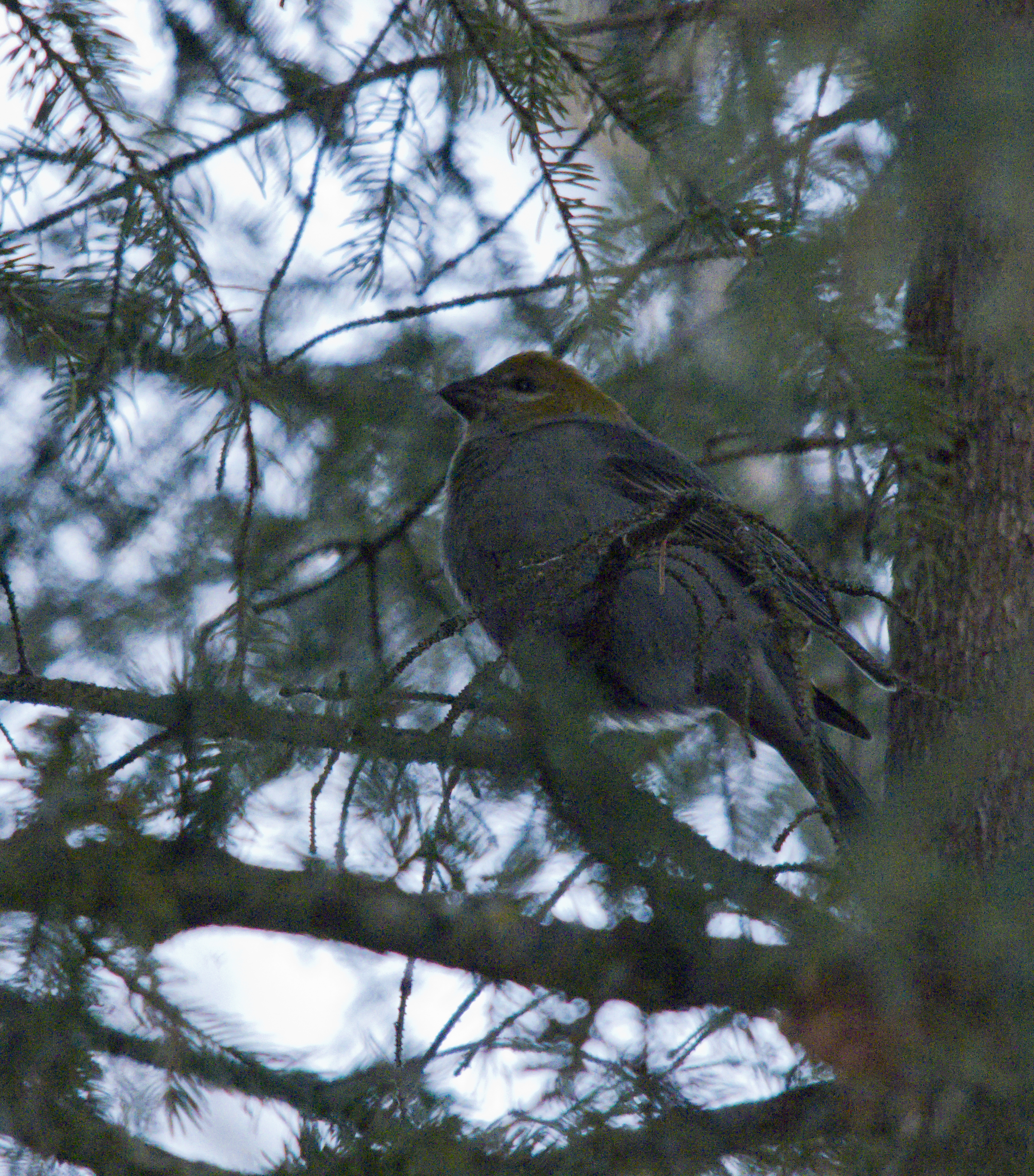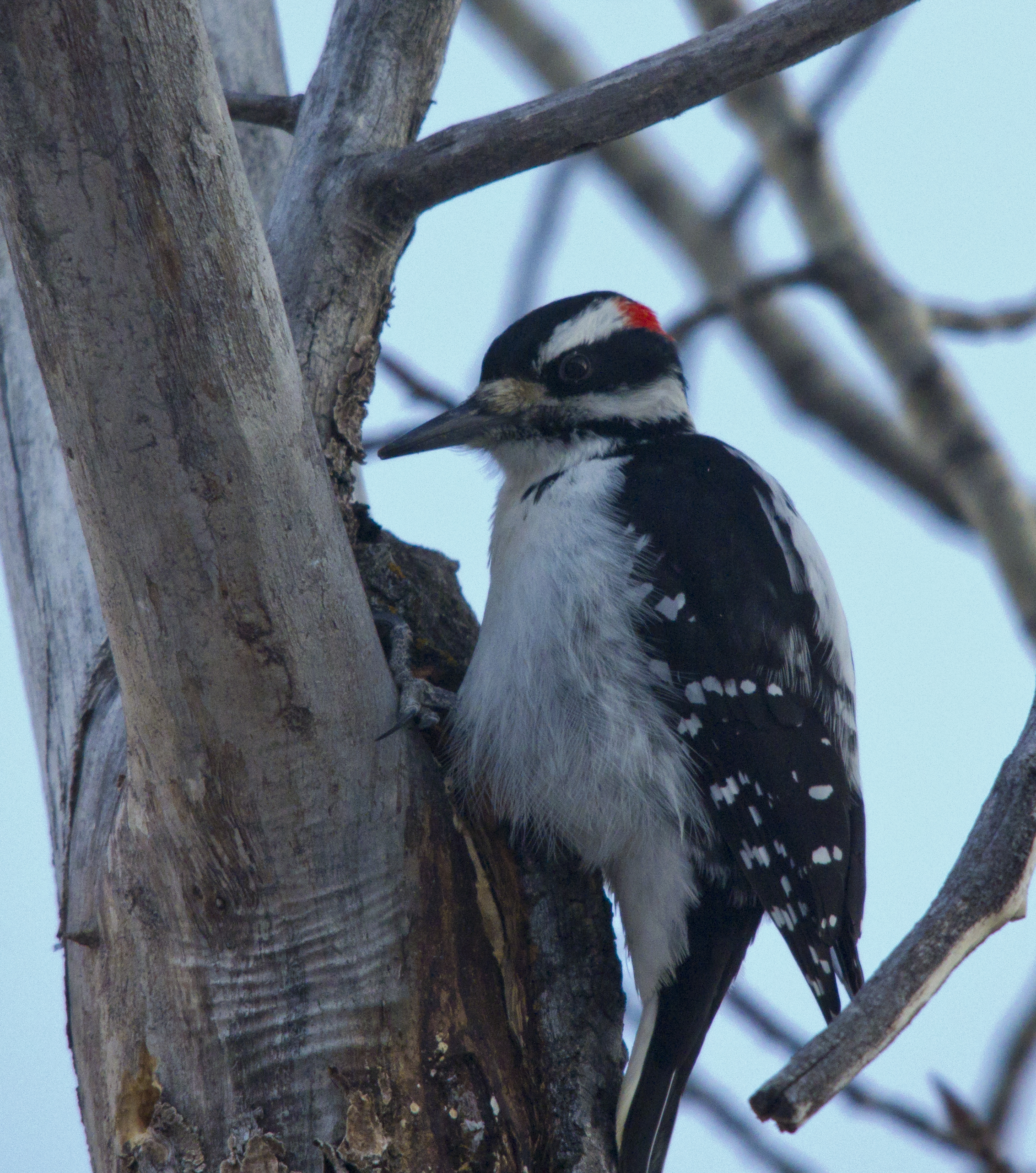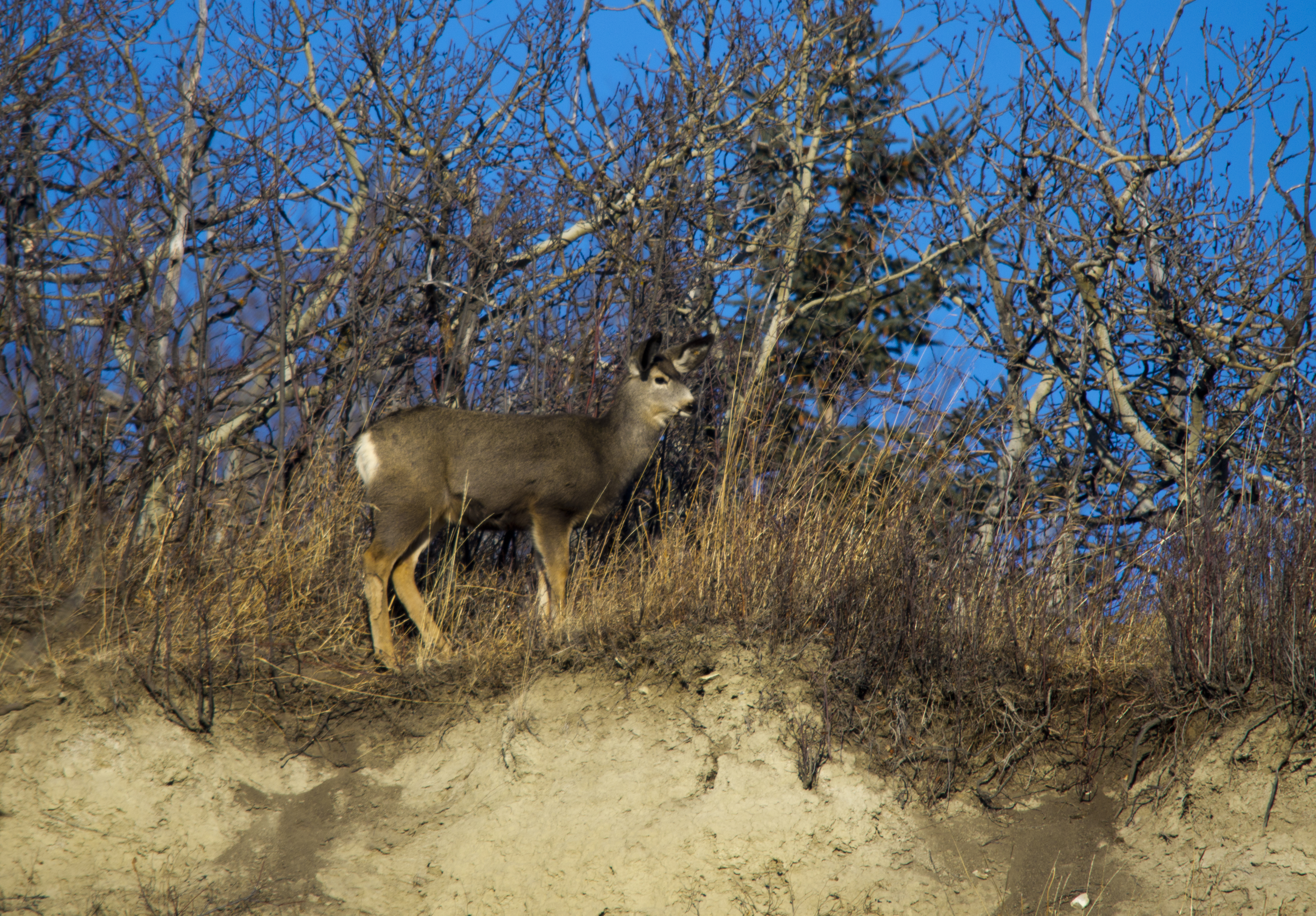Rob English managed to get some great shots of the rare woodpecker living in High River this winter. Click to enlarge.
Rare Bird Alert Calgary: Jan 6
Have you seen an unusual bird in Calgary? If it is on this Reportable_Birds (PDF), please report it to the Nature Calgary Rare Bird Alert line at 403 221-4519 and leave a message after the beep at the end of the recording. If you would like some help with species identification, us email us at zoxox@shaw.ca To report injured wildlife call the Calgary Wildlife Rehabilitation Society at 403 239-2488, or the Alberta Institute for Wildlife Conservation at 403 946-2361.
This report was prepared on Thursday, Jan 5.
Wednesday, JANUARY 4
–TOWNSEND’S SOLITAIRE (4) – Elbow River monthly survey by Gus Yaki and CFNS field trip
–RED-BELLIED WOODPECKER (1) – George Lane Park in High River by Jeff ____
Tuesday, JANUARY 3
–HOODED MERGANSER (1m) – Elliston Park in SE Calgary by Terry Korolyk and Bob Lefebvre
–NORTHERN PINTAIL (1m) – Ralph Klein Park in SE Calgary by TK
–KILLDEER (10) – 6 at Hull’s Wood, 1 at Bankside, 3 at Mallard Point,all in Fish Creek PP, by TK
–TOWNSEND’S SOLITAIRE (2) – Brittania subdivision in SW Calgary by Phil Cram
–RED CROSSBILL ( 25) – Britannia by PC
Monday, JANUARY 2
–LESSER SCAUP (1f, 1m) – Hwy 22x bridge over the Bow R by TK
–GREEN-WINGED TEAL (1f) – Mallard Point in Fish Creek PP by TK
–COMMON GOLDENEYE X BARROW’S GOLDENEYE (1m) – Policeman’s Flats, SE of Calgary off Dunbow Rd, by TK
Sunday, JANUARY 1
–KILLDEER (3) – Carburn Park by Jeff Bingham
The Fish Creek PP annual New Year’s Day Bird Count reported the following:
–REDHEAD (1)
–GADWALL (1)
–RED-TAILED HAWK (1)
–PRAIRIE FALCON (1) – Hwy 22x bridge over the Bow R
–KILLDEER (record 15)
–EURASIAN COLLARED-DOVE (1) – new for the count
Falcon Identification
We received some absolutely stunning, stupendous photos of a falcon from Jim Walling. These were taken on Dec 30, mid afternoon along the Bow River at the Inglewood Bird Sanctuary. He only managed to capture these three shots before the bird was gone.
Two of us here at the blog identified it as a Prairie Falcon, based on the moustachial line and the dark bar on the wing lining. However, neither of us have even seen a Prairie Falcon that is this light in colour. Some web research turned up a number of similar pictures of a Saker Falcon, a European bird used in the art of falconry.
Do we have any falconers reading this blog?! Or is this an unusually white Prairie Falcon? Your comments, please!
Posted by Pat Bumstead
Update January 9
What a dearth of comments on this bird. None of us are confident enough in our raptor ID to take a stand, but fortunately we have birding experts to give us a hand. Gus Yaki said this is a second year Prairie Falcon, and Gord Court also said this is a juvenile Prairie Falcon. Firm identification, for sure!
Rare Bird Alert Calgary: Jan 2
Have you seen an unusual bird in Calgary? If it is on this Reportable_Birds (PDF), please report it to the Nature Calgary Rare Bird Alert line at 403 221-4519 and leave a message after the beep at the end of the recording. If you would like some help with species identification, us email us at zoxox@shaw.ca To report injured wildlife call the Calgary Wildlife Rehabilitation Society at 403 239-2488, or the Alberta Institute for Wildlife Conservation at 403 946-2361.
This report was prepared on Monday Jan 2.
Bird Sightings:
–RED-BELLIED WOODPECKER (1) – seen by many observers in High River’s George Lane Park or coming to Karen Scott’s feeder at 506 – 4 St (bordering the park)
Sunday, JANUARY 1
–SNOWY OWL (many) – 18 seen by Ron Kube on a trip to Rockyford and return to Calgary (route was E on Hwy 564 to Rockyford then return W on Hwy 9 and back roads, S on RgeRd 253 to NW of Strathmore, then returning to Calgary on Hwy 564 and RgeRd 262; 4
owls seen by Terry Poulton on TwpRd 262 between RgeRds 242 and 254; another owl seen independently by both Terry and Eddy
Matuod on Country Hills Blvd and Barlow Tr in NE Calgary; and finally a Snowy seen by Eddy on Symon’s Valley Rd, 800 m S of Big Hill Springs Rd
–PRAIRIE FALCON (1) – corner of 144 Ave NW and RgeRd 15 by EM
–NORTHERN HARRIER (1) – Calgary Zoo’s private facility SE of Calgary by Dwight Knapik
Saturday, DECEMBER 31
–SNOWY OWL (7) – between Beiseker and Drumheller by David Pugh
–NORTHERN HAWK OWL (1) – Hwy 596 just W of Turner Valley by Daniel Arndt
Friday, DECEMBER 30
–PRAIRIE FALCON (1) – Inglewood Bird Sanctuary by Jim Walling
–AMERICAN DIPPER (1) – Fish Creek PP just east of Macleod Tr by Bob Lefebvre
–NORTHERN GOSHAWK (1) – Fish Creek PP, just S of Bebo Grove by Bill Wilson
Thursday, DECEMBER 29
–LESSER SCAUP (1f) – channel on W side of Bow River just SW of Glenmore Tr bridge by BW
–NORTHERN PINTAIL (1m) – S of Deerfoot Tr, N of Beaverdam Flats by BW
–DUCK sp (1) – unusual duck somewhat like an American Black Duck but with a white speculum and white throat with few markings seen near the footbridge to Prince’s Island Park by K O’Connell
The next scheduled update of the Bird Alert is on Thursday, Jan 5, 2012.
BIRD STUDY GROUP – Meets the first Wednesday of the month, 7:30 pm, Room 211, BioSciences Building, University of Calgary. The next meeting will be Wednesday January 4. The program will be a review of local Christmas Bird Count results.
19th Annual Fish Creek Park New Years Day Bird Count
Last week I was asked by Bob Lefebvre if I would be interested in participating in the Christmas Bird Count for Fish Creek Provincial Park, and I immediately jumped at the chance. I always look forward to the walks in Fish Creek Provincial Park, and I was very glad to be grouped once again with Gus Yaki, Bob Lefebvre, along with 11 other participants to do the count in the Marshall Springs area of Fish Creek.
If you’re not familiar with the area, Marshall Springs is located between Bebo Grove and Votier’s Flats, on the west side of Fish Creek Park, just south of the Bow River. I started up the GPS on my phone and mapped out our walking route, to explain a bit more graphically the route we took. I’ll be experimenting with this format in future posts, so let me know how you like it!
Starting at the parking lot to Bebo Grove, we trekked south through the woods, then crossed the river into the Marsall Springs area proper. On the whole, I didn’t end up taking as many photos as I would have liked to, mostly due to the relatively quiet morning we had in terms of both species present, and population. One of the first birds seen all morning was this Pine Grosbeak, along with one other, in the trees just north of the base of hill at the southern boundary of the park.
If there was any bird that I felt best described the walk though, I would have to say it was the Downy Woodpecker, the first of which we spotted shortly after the Pine Grosbeak, tap-tap-tapping away at the trees for some food.
Followed shortly by our first sighting of a Hairy Woodpecker, also searching for food under the bark of the poplars and birch.
I don’t know whether it was the company, the conversation, or the lack of birds present, but most likely a combination of all three that found my next photos taken near the end of the walk, when this Pine Grosbeak called from a nearby treetop, and across the banks of Fish Creek this White-Tailed Deer grazed on the edge of the slope.
We convened later with the larger group near the main office of Fish Creek Provincial Park to collaborate data and share any interesting finds. Our group though had a fairly small number of species and individuals, and aside from a large overflight of Bohemian Waxwings, we had less than 100 individual birds among 12 species in our count area, detailed below:
11 Downy Woodpecker
1 Hairy Woodpecker
45 Black-capped Chickadee
4 Red-breasted Nuthatch
1 White-breasted Nuthatch
2 Common Redpoll
2 White-winged Crossbill
100 Bohemian Waxwing
11 Common Raven
8 Black-billed Magpie
1 Brown Creeper
8 Pine Grosbeak
One bird did stand out from the crowd at the reporting though, which Bob and I went in search of shortly after. I leave you with a (relatively bad) photo of a rare Winter Red-tailed Hawk, seen on the east end of Fish Creek Park.
Posted by Dan Arndt
Sunday Showcase: Pine Grosbeaks
Rob English took these shots in December right outside his house, resulting in some great pics and a life bird for himself! Rob says, “the pictures on the ground are of one who had crashed into the neighbor’s window. The first one is right after she hit and the last one was just before she was flying again. I watched her for about 45 minutes before she flew just to make sure the cats didn’t get her. The robin was hanging out in the tree with these guys. There must have been about 15 female grosbeaks and only one male.” Click to enlarge.
A Canada Big Year
Four Calgary birders – Ray Woods, Brian Elder, Mike Mulligan and Phil Cram – are planning to do a Canada-wide Big Year in 2012. A Big Year is an attempt to see or hear as many species of birds (and mammals in this case) as possible in a calendar year, in a specific geographic area. Our four local birders are going to confine their activities to Canada, but they intend to see as much of Canada as possible, travelling to all the provinces and territories.
Their goal is to get 500 birds and mammals combined, and of course each of them has individual goals as well about extending their life lists or Canada lists, or seeing particular species.
They have started a blog to track their progress, and it’s going to be fascinating to watch their quest unfold. They will begin here in Calgary on New Year’s Day with the Fish Creek Park bird count.
Northern Pygmy-Owl, one of the birds they hope see in the Calgary area in early January.
There are already some posts on their blog giving details of their plans and itinerary. Check it out at Fur & Feathers 500 – it will definitely be a blog worth following in the coming year.
Posted by Bob Lefebvre
Rare Bird Alert Calgary: Dec 29
Have you seen an unusual bird in Calgary? If it is on this Reportable_Birds (PDF), please report it to the Nature Calgary Rare Bird Alert line at 403 221-4519 and leave a message after the beep at the end of the recording. If you would like some help with species identification, us email us at zoxox@shaw.ca To report injured wildlife call the Calgary Wildlife Rehabilitation Society at 403 239-2488, or the Alberta Institute for Wildlife Conservation at 403 946-2361.
This report was prepared on Thursday December 29.
Bird Sightings:
Dec. 26:
–NORTHERN PINTAIL(M), Bow River, north end Carburn Park, by Bill Wilson.
–GREEN-WINGED TEAL(F), Bow River, near storm-water outfall S.of the Ivor Strong bridge, by BW.
–PILEATED WOODPECKER, Bebo Grove, Fish Creek PP, by BW.
Dec. 27:
–CINNAMON TEAL (possible female), Bow River, below the weir at Wyndham-Carseland PP. Not positively identified as such, but the bird seems to have all the right ID features, by Terry Korolyk.
Dec.28:
–AMERICAN ROBIN(5), centre of the Weaselhead , west end of Glenmore Park.
–DARK-EYED JUNCO(5), in a yard in the Southview area in SE Calgary.
–GOLDEN-CROWNED KINGLET(1), same as above.
The next scheduled update of the Bird Alert is on Monday, January 2, 2012.
Wednesday Wings: Varied Thrush
On of my favourite Christmas presents this year was an adult male Varied Thrush that arrived in our front yard on Christmas Day, just as we were opening our gifts.
When it first flew across our front yard, I thought it was a robin, a bird it is closely related to. I saw a robin in the neighbourhood as recently as December 17. But the male Varied Thrush has unmistakable orange and black markings.
These beautiful birds are not too common in Calgary, with just a few reports every year on migration, and the occasional one overwintering here. This one appears to be trying to overwinter in our neighbourhood, as it has now been seen feeding in our yard for three straight days. This is the first time we’ve had one in our yard, and only the second one I’ve seen in Calgary. We didn’t have one reported on the recent Christmas Bird Count, so I wonder where this bird was then?
Here is a video of the Varied Thrush feeding on niger and sunflower seed.
Posted by Bob Lefebvre
Rare Bird Alert Calgary: Dec 26
Have you seen an unusual bird in Calgary? If it is on this Reportable_Birds (PDF), please report it to the Nature Calgary Rare Bird Alert line at 403 221-4519 and leave a message after the beep at the end of the recording. If you would like some help with species identification, us email us at zoxox@shaw.ca To report injured wildlife call the Calgary Wildlife Rehabilitation Society at 403 239-2488, or the Alberta Institute for Wildlife Conservation at 403 946-2361.
This report was prepared on Monday December 26.
Bird Sightings:
October – December 26: –RED-BELLIED WOODPECKER: Around since October 2011, the woodpecker continues to be seen in the same location as previously reported, in High River.
Dec. 24:
–NORTHERN HAWK OWL: Just west of Turner Valley along Hwy.546. Seen previously on Dec. 19.
–NORTHERN SHRIKE: Glenmore Reservoir, south escarpment W.of yacht club. By Bill Wilson.
–EURASIAN COLLARED-DOVE: Deer River Green, SE Calgary, by Dave Breckon.
–PEREGRINE FALCON: W. of Black Diamond.
–TUNDRA SWAN(1): Frank Lake. Previously reported from the High River CBC.
Dec. 25: –VARIED THRUSH:(1), seen in yard of Bob Lefebvre in SE Calgary.
Dec.26: –SNOWY OWL(3), east of Calgary, by Terry Korolyk.
The next scheduled update of the Bird Alert is on Thursday, December 29.





































